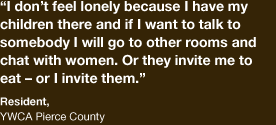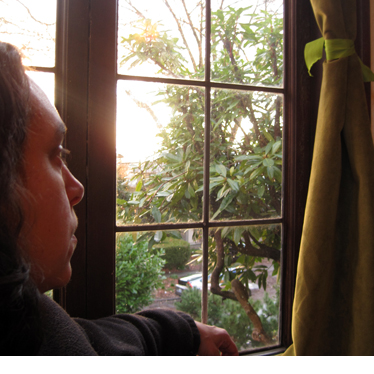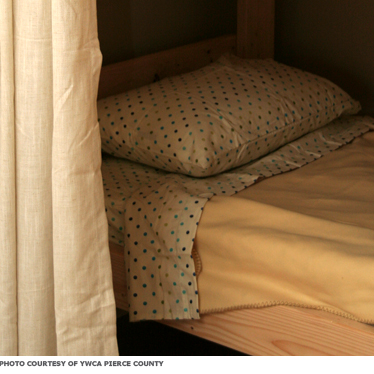
Empower
Making one’s own decisions; reclaiming the autonomy and dignity eroded by abuse
Private rooms for single women and families facilitate healing from trauma.
WSCADV’s focus groups with shelter residents indicated that most residents prefer single rooms because they offer greater privacy, reduced noise, reduced embarrassment and improved quality of sleep. Survivors spoke about wanting to lock the door when they are in a room, as well as when they leave it.
In a King County, Washington study focusing on the cultural accessibility of shelters, the authors found that shelter residents and advocates recommended providing more privacy for residents, noting that
“some of the interviewees mentioned that clients sometimes feel that they are always being watched and that they never have enough time alone, especially quiet time by themselves or with their children.”
(Kerri Kumasaka and Gretchen Test, Culturally Competent Shelter Alternative Project, King County Women’s Programs, 1992, p. 21)
In their extensive, multi-state study of survivor’s experiences in shelter, Eleanor Lyon, Shannon Lane and Anne Menard found that being unable to find privacy was one of the most common problems residents reported, and one of the problems that was the least likely to be resolved. Less than half of the survivors reporting this issue said that the issue had been resolved to their satisfaction, in contrast to many other issues that were resolved 75% of the time or more. (Lyon, Bradshaw and Menard: Meeting Survivors’ Needs, November 2011).



Domestic violence abusers often demand emotional, physical and sexual availability at all times, and deny their partner’s right to set boundaries. Survivors and their children may have been woken in the middle of the night to be assaulted or harangued. The ability to feel secure and in control of one’s physical environment, choose when to be social and when to be alone or just with one’s children all facilitate healing from trauma and abuse. Going to sleep knowing that no one can enter one’s room also increases feelings of security.

Beauty is healing. In focus groups, shelter residents indicated their appreciation for art, inspiration and beauty in shelter.
Beauty is not about expensive materials or luxury. Present in many things, it can be expressed by bringing in nature, and by thoughtful use of color, proportion and texture.
Colors that resonate with the communities served can have positive associations and make a space feel uplifting, familiar and friendly. It can be tempting to utilize dark colors for furniture or even walls to hide dirt, but these have a tendency to look heavy and show wear. Wall and ceiling colors can also have a marked effect on the brightness of a space; light colors reflect light and make a room brighter, while dark colors absorb light.



Detail from a mural painted by a local artist in one of the apartments at the YWCA Pierce County.
Independent control of lighting allows residents and staff to adjust levels of light in individual rooms/units and in the communal spaces to create intimacy or facilitate tasks (for example, reading light next to sofa, overhead lights, operable windows, and ceiling fans).
Independent control of thermostats allows residents and staff to adjust temperatures in individual rooms/units to accommodate sensitivity to temperature.


At the Plaza Apartments, an affordable housing development in San Francisco, individuals can control airflow, temperature and lighting in all occupied spaces.

People suffering from depression are often cold because their blood pressure drops. Alternatively people suffering from anxiety disorders – even transitory problems with anxiety – tend toward feeling overheating with elevated temperatures and sweaty palms. (Institute for Human centered Design, Seattle, Washington: Site Visit Report & Recommendations/Information Resources, August 2009)
Hardwood or linoleum floors, washable area rugs and microfiber or leather furniture simplify keeping these rooms clean.
Service animals are critical to everyday functioning for those who use them.


The “women’s retreat” at one program – intended to be a child-free space for meditation, reflection and quiet – was highly valued by residents for the refuge it provided from the busy, noisy common spaces and shared rooms.
For residents with mental health issues, especially those with anxiety, some larger communal spaces may be too stimulating. A quiet space can provide a welcome alternative to the other communal spaces.

Sliding panels and curtains, daybeds and Murphy beds, and movable furniture can be used to hide clutter and personal effects; create open space for non-sleeping functions and socializing; and allow privacy between family members.


(conversation with Valerie Fletcher, Institute for Human Centered Design)
For more strategies that support residents’ comfort and control, see
Communal Space: Empower
